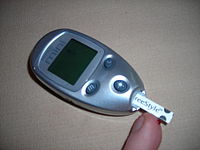
Photo from wikipedia
The sow at parturition is challenged with respect to energy status due to increases in energetic expenses associated with 1) nest building 2) uterine contractions and 3) colostrum production. A… Click to show full abstract
The sow at parturition is challenged with respect to energy status due to increases in energetic expenses associated with 1) nest building 2) uterine contractions and 3) colostrum production. A previous study indicated that sows were depleted of glucogenic energy around farrowing. The aim was to investigate whether intravenous infusion of glucose from observed nest building behavior to 24 h postpartum affected the farrowing kinetics and colostrum production in sows. Ten multiparous sows (DanBred landrace × DanBred Yorkshire) were fitted with a jugular vein catheter on each side (one for infusion, one for blood sampling). Sows were infused with either 0.9% saline (CON; n=5) or 10% glucose (GLU; n=5) solution at a constant rate of 125 ml/h. From day 108 of gestation, sows were fed once daily with 3.33 kg of a standard lactation diet. During farrowing sows were monitored to register the onset of farrowing, time of birth, birth status (live or dead), sex, stillbirth rate (SR) and weight of newborn piglets. Farrowing assistance (FA) was provided when birth interval exceeded 60 min. In late gestation, 1 mL of blood was collected every third h for blood gas analysis and every sixth h for harvesting plasma. During farrowing, 1 mL (for blood gas) and 9 mL blood was collected at 0, 3, 6, 9, 12, 15, 18, 21 and 24 hours in milk (HIM). Colostrum and milk samples were collected at 0, 6, 12, 18, 24 and 36 HIM and also at 3, 10, 17 and 24 days in milk. Compared with CON sows, GLU infusion decreased the SR (16.1 vs 7.4%; P= = 0.03), FA (21 vs 9.0%; P = 0.01) and surprisingly also blood glucose at onset of farrowing (5.53 vs 5.09 mmol/L; P = 0.03), respectively. A tendency to higher plasma lactate at the onset of farrowing (P = 0.05) but decreased piglet mortality from 0-24 h (P = 0.06) were also found for GLU sows. No effects of treatment on farrowing duration or mean birth intervals were found. Lactate in whole blood (P = 0.003) and plasma (P = 0.002) was increased for GLU sows as compared with CON sows during the colostrum period. No effect of GLU infusion was seen on colostrum and milk composition and yield. The increase in lactate was most likely due to a shift towards a greater proportion of glucose oxidation and insufficient O2 supply to fuel uterine contractions. In conclusion, infusion of glucose reduced the frequency of SR and FA, and improved energy status of the sow seems to be a crucial trait to enhance total piglet survival.
Journal Title: Journal of animal science
Year Published: 2021
Link to full text (if available)
Share on Social Media: Sign Up to like & get
recommendations!